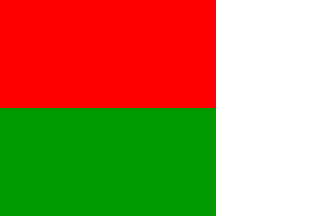 zachary harden
zachary harden
Keywords: oecussi ambeno | coat of arms | oé-cussi | micronation | quatair / ocussi ambeno | madagascar | imaginary | hoax |
Links: FOTW homepage | search | disclaimer and copyright | write us | mirrors

Last modified: 2023-06-03 by  zachary harden
zachary harden
Keywords: oecussi ambeno | coat of arms | oé-cussi | micronation | quatair / ocussi ambeno | madagascar | imaginary | hoax |
Links: FOTW homepage |
search |
disclaimer and copyright |
write us |
mirrors
 image by Antonio Martins, 11 October 1999
image by Antonio Martins, 11 October 1999
There is someone in New Zealand who issues stamps for Ocussi
Ambeno — but this is not the Timorese one, but is rather a
micronation, in much the same way as one other micronation is called
Reunion.
James Dignan, 09 December 1997
On [mchXX], under the title
"Soukrome staty" there are 11 images of imaginary states,
including Ocussi Ambeno: red over green with at the fly [!] a white vertical
stripe (so, like the flag of Madagascar mirrored).
No source is given.
Mark Sensen, 11 October 1999
Soukrome staty means "private countries" or
"privately owned countries"…
Joàn-Francés Blanc, 12 October 1999
The “self proclaimed” sultanate was proclaimed by Bruce Henderson after 1968. The Sultan in 1968 was Wallis Abdullah I, and later Michael Abdullah. The postal addresses are:
Sultanate of Quatair / Ocussi Ambeno,I don’t know the flag but the coat of arms is with two oval wreaths, a crown above and 18 circles within the oval (in line 3, over 4, over 5 over 6, each time greater, over the word QUATAIR, over 8 five pointed stars over a great five pointed star. In the bottom a ribbon with the inscription "onward".
PO box 876, Auckland, New Zealand; or
Markpress box 21240, Auckland, New Zealand; or
Box 1619, Brisbane 4001, Australia
It sounds dreadfully
overdesigned. And inscription would likely be in Portuguese, Bhasa
or Arabic. There’s no English connection beyond this
Auckland clique that I’ve ever heard of, so
that’s probably how it got to say "onward".
Stephen Collier, 07 October 1999
www.okusi.org/oa is the
page of Okusi Ambeno Sultanate
<oastamps@post.com>
is the page of postal products I received a beautiful file about next
post emission. In the upper part is the emblem of the Ministry of post,
with the arms of… Brunei!!
Jaume Ollé, 03 April 2000
That’s not surprising, since everything in that
“sultanate” is a hoax. It’s just an internet-based
micronation with a spurious claim to territory in real world.
Jorge Candeias, 03 April 2000
Yep, and the “national” coat of arms of this so called sultanate
is the arms of Indonesia with the central shield blurred
off. Hardly imaginative, but… No flags, anyway. I still don't understand
if this is just a joke of some kind (the website has a lot of “give-aways”, like that bit about hallucinogenic mushrooms being a major
export, or that garudas really exist), or if they are still conning keen and
not-so-clever philatelists.
António Martins, 04 April 2000
The so-called “sultanate” is a fiction, one of the
many micronations that have been created in the last
decades. Unlike some of these micronations (who have
real territory where real people live and claim
independence), this had only “territory” on the
Internet and on stamps catalogues. Also, the people
there are overwhelmingly Christian (which is also a
political statement of resistance against the
Indonesian oppressor, predominantly Muslim), so it
couldn’t be a sultanate. This helps to show the deep
ignorance of the guy who invented the sultanate story
about the sociological reality of the enclave, which
is also quite common in micronations that claim chunks
of “real-world” territory.
Jorge Candeias, 08 October 1999
Sometime in the mid 1970s, he printed letterheads for the non-existent Consul General of Ocussi Ambeno, from Auckland (address i forget, but i saw these). He explained that he had discovered that Ocussi Ambeno “didn’t actually exist”, but was listed in atlases nevertheless. Around the same time, he and others printed extremely basic postage stamps to back up the nation’s reputation. These were done with rubber stamps individually, and featured cats, fish, teddy bears and steam trains. I was told that these were never intended to be taken seriously, but they were submitted without laughter to an international philatelic journal with covering letterhead from the “consulate” and appeared in the next issue as a curiosity — in the so-called Cinderella section. I saw this issue.
This is as much as I can vouch for, and it’s a shame I can’t verify what happened next…though i did see many sample sets of the “real” stamps. Here’s the story:
Two months later, a major European-based engraver/publisher writes to the consulate in Auckland and expresses cordial greetings, sympathy for the position of struggling small nations etc. Oblique correspondence gives way to enquiries about the diplomatic hierarchy; is the sultanate’s man in Auckland the senior man overseas? does the consulate in Auckland have any particular needs that could be addressed? It’s noted that he is a keen philatelist. It’s pointed out that the publishing company prints stamps, very good ones, and specializes in international “covers”, large packages and long term client relationships. Company would be prepared to pay “fee” for exclusive contract, and right to market commemorative sets to investors…
And the story goes that $US 30 000 changed hands. Everything was done properly and quickly; the stamps arriving in time for the Queen’s silver jubilee — that was the theme they celebrated. The printer placed tropical fish and animals on them, for reasons of continuity no doubt.
The money went on parties, and when they’d sobered up and realised that the printer wouldn’t prosecute them but might well take action privately, the rest of it went on changing identities and moving to Australia.
Stephen Collier, 07 October 1999
Other sites: